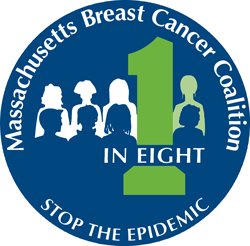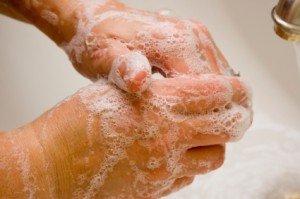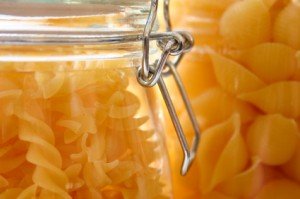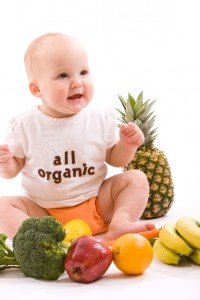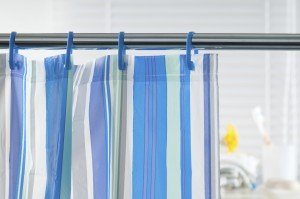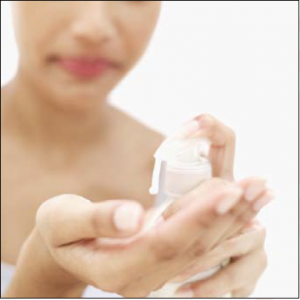Many chemicals of concern are industrial chemicals that don’t stay isolated inside factories. Studies have found hundreds of man-made chemicals in our air, water, food, consumer products, and in samples of human blood and urine. Let’s Talk Prevention: Reducing Toxic Exposures is a program to prevent diseases, like breast cancer, by describing ways to avoid common chemicals of concern linked with negative health impacts. Review the information below for tips on reducing toxic exposures and choosing safer alternatives to harmful products. Use the button below to view or download the handout:
See Below for MBCC’s Let’s Talk Prevention Handouts in English and 10 Other Languages
Seven Basic Steps to Reduce Exposure
Here are seven of the easiest steps you can take to reduce exposure for yourself and your family. Don’t become overwhelmed – start with small steps to reduce exposure and increase from there! Click on each tip below to read more.
1. Wash your hands
Wash your hands frequently, especially before eating, and after handling chemicals like cleaning products. Use soap without parabens and triclosan (see the section below for more information about these chemicals).
2. Take off your shoes
Leave shoes at the door to avoid tracking pesticides and other chemicals inside. Ask guests to do the same. Chemicals tracked into your home can build up inside carpeting and pose risks, especially to babies and pets.
3. Shorten showers
Take shorter showers to limit inhalation of airborne chemicals and reduce skin absorption of chemicals from water and shower products.
4. Keep air fresh
Open windows every so often to ventilate indoor air. Don’t allow smoking inside and avoid using commercial air fresheners which can contain unsafe fragrance chemicals. Toxic chemicals, such as flame retardants (see below), can settle in dust so keep dust levels low by using a vacuum with a HEPA filter and cleaning with a microfiber cloth – these naturally trap dust and dirt without chemical additives.
5. Store food safely
Reduce the amount of time your food is stored in the original packaging. This will reduce your exposure to any food additives or preservatives added to the packaging. Transfer your food (and leftovers) into an airtight glass, stainless steel, or ceramic container. Try not to use plastic food and beverage containers and avoid microwaving plastic. Chemicals like BPA and phthalates (see section below) can move from plastic into food, especially when heated.
6. Buy fresh and organic
Buy organic produce as often as possible. Fresh is best but go for dried or frozen instead of canned. This will reduce exposure to pesticide residues on produce and food additives in cans such as BPA and phthalates (see section below).
7. Educate
Educate yourself and your family about the dangers of toxic chemicals. Investigate safer alternatives to products you use often such as cleaning products, toiletries, cosmetics, lawn care, etc.
Know these common chemicals of concern…
BPA (Bisphenol A)
BPA can be found in food can linings, store receipts, and plastic products like water bottles, food containers, and toys.
To reduce exposure, use fresh or frozen foods instead of canned and avoid microwaving plastic containers.
If the number in the triangle is a 3, 6, or 7, skip it.
Number 3 plastics are easy to remember by the 3 letters PVC (or vinyl). This plastic often contains lead, cadmium, phthalates, and DEHA – all of which are toxic to humans. PVC makes the rounds, appearing in toys, shower curtains, cling wrap, some plastic squeeze bottles, plumbing, and furniture. Fortunately, we have noses that can help tip us off as PVC has a distinct plastic-y smell.
Number 6 plastics or polystyrene contain styrene, which is toxic to the brain and nervous system, and additives in number 6 plastics act like estrogen, which may be linked with breast cancer. Avoid this plastic in styrofoam, egg cartons, cups, carry out containers, and opaque plastic cutlery.
Polycarbonate plastic (7) contains bisphenol A (BPA), another chemical which mimics estrogen and linked with breast cancer. Hard, shatterproof bottles often contain this. Switch to stainless steel or glass bottles to reduce exposure.
Flame Retardants

Flame retardants such as PBDE and others are used in electronics, children’s pajamas, and furniture.
These chemicals can also settle in house dust so keep dust levels low to reduce exposure inside your home (see “Keep air fresh” section above).
PAHs (Polycyclic Aromatic Hydrocarbons)
PAHs can be found in charred meats, tobacco smoke, and car exhaust.
You can minimize char when grilling by using marinades, reducing heat level and avoiding prolonged cooking times.
Parabens
Parabens are used in toiletries and cosmetics.
To avoid parabens, check for products without parabens as an ingredient or those labeled “Paraben-free.”
Perfluorinated Compounds


Perfluorinated compounds are used in stain resistant clothing/fabrics, grease-proof food packaging, and nonstick cookware.
To reduce exposure, use cast iron or steel clad pots/pans instead of nonstick and try to avoid clothing and carpeting labeled as “stain resistant.”
To learn more about MBCC’s campaign to remove PFAS from food packaging, please click here.
Pesticides
Pesticides include weed and bug killers used inside the home, in the garden, or nearby in agriculture.
To reduce ingestion of pesticide residues on fruits and vegetables, try to buy organic produce whenever possible. To avoid pests without the use of chemical pesticides, store food tightly, wipe up crumbs, and seal cracks in windows and doors.
Phthalates
Phthalates are used in soft plastics like shower curtains, fragrances, toiletries and cosmetics.
To reduce exposure, try to avoid pliable plastic products and opt for cloth shower curtains instead of vinyl.
Triclosan
Triclosan can be found as an ingredient in toiletries and cosmetics, especially in antibacterial soaps.
Luckily, triclosan is usually listed as an “active ingredient” on personal care product labels. To avoid exposure, check labels for products without triclosan.
Take time to read product labels
Some products may contain chemicals that are not listed on the label. For example, the ingredient “fragrance” can represent large mixtures of potentially harmful chemicals. However, making a habit of reading labels can help you identify and avoid harmful ingredients that are listed.
When you’re checking labels keep these tips in mind:
Choose cleaning products, toiletries, and cosmetics labeled as “fragrance-free.” Even products labeled as “unscented” can include unlisted fragrance masking compounds.
Look for “flame retardant-free” and not “flame resistant” or “TB 117 compliant” on children’s pajamas, furniture, and bedding.
Try to avoid cookware, clothing, and furnishings labeled as “stain resistant” or “non-stick.”
